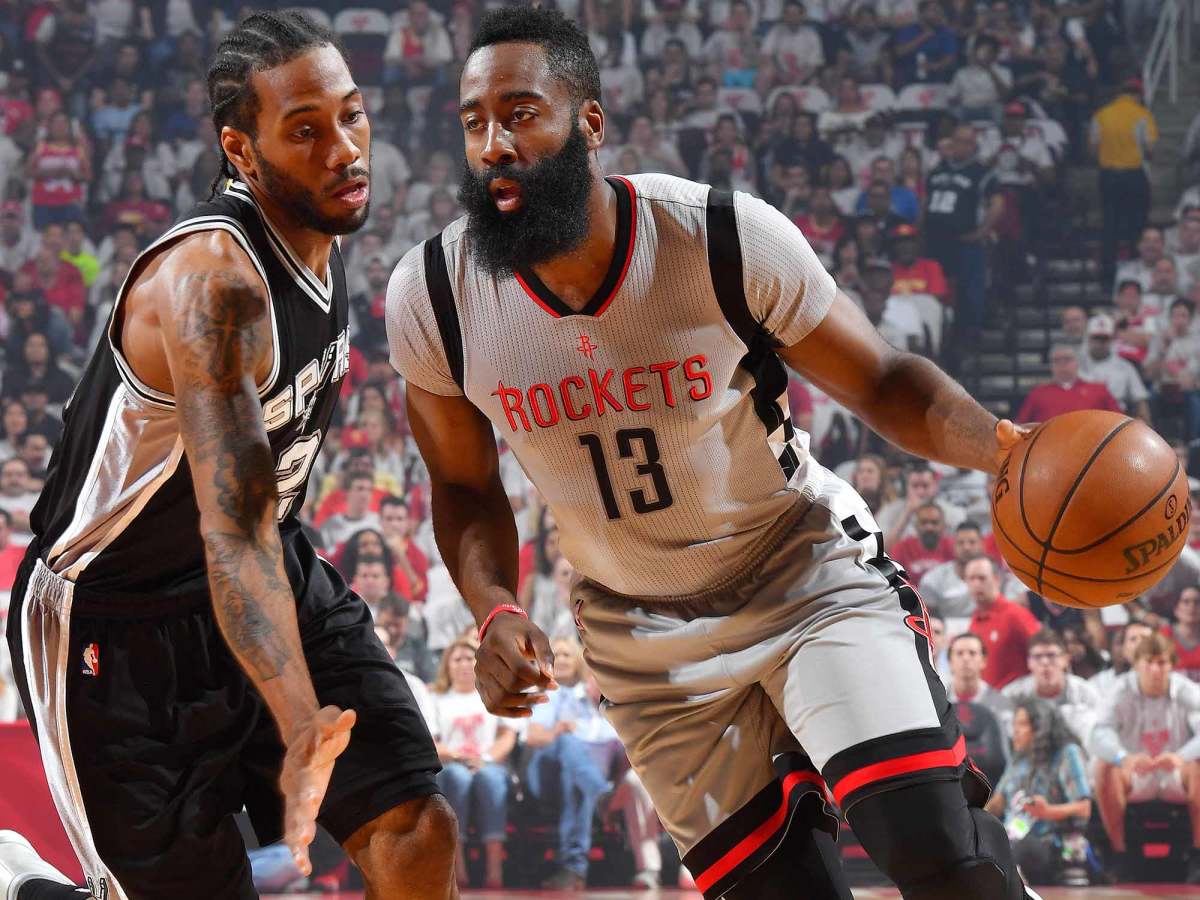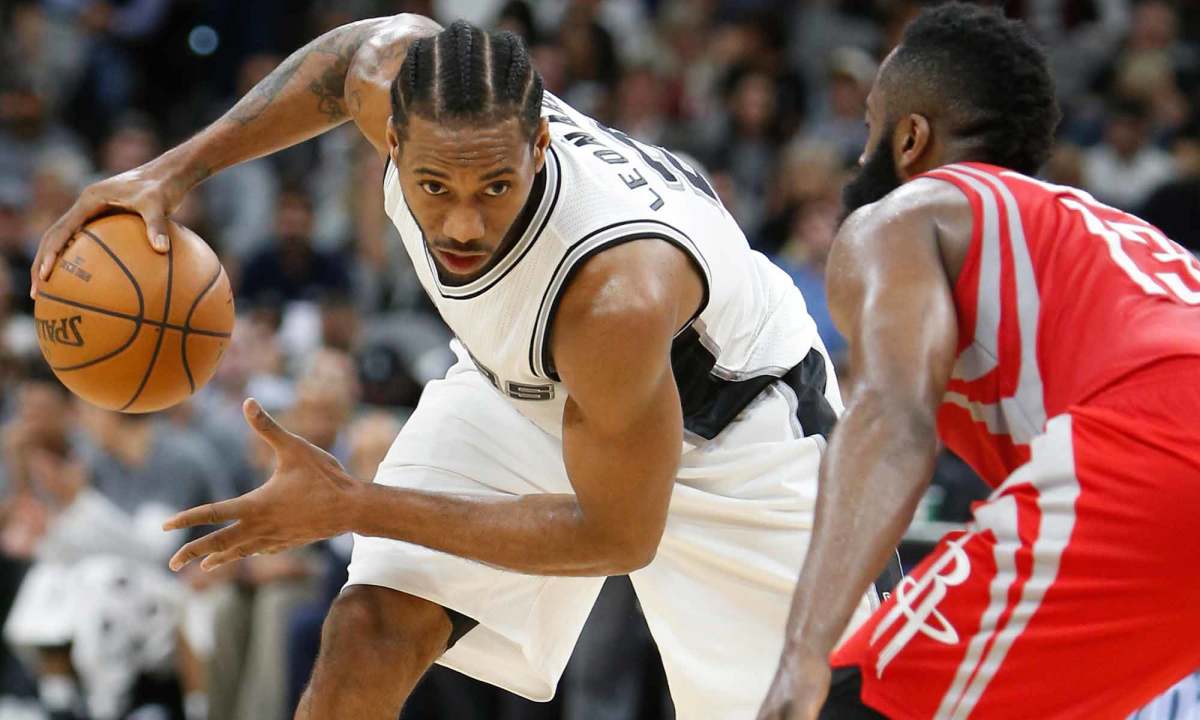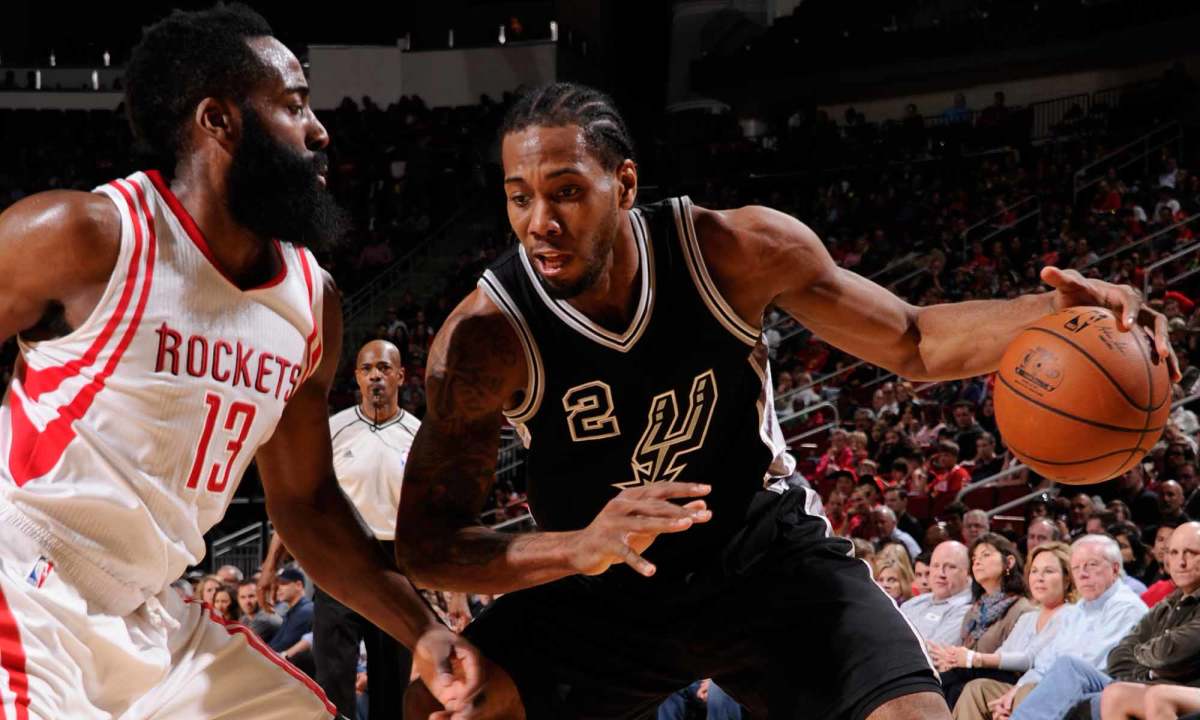Watch & Learn: Studying The NBA’s Silent Stars

HOUSTON — James Harden and Kawhi Leonard have traded hammer dunks and dagger threes in their deadlocked playoff series but not likely so much as a single word. The signature duel of the second round has been waged in reservation. Leonard can squeeze the life from a game in utter silence. Harden is more expressive—for every occasion, there is a celebratory pose—but rarely chatty on the court. There is less a cult of personality around the two superstars than one of physicality. The beard. The claw. The wingspan. The strength. Part of the reason why both Harden and Leonard are defined by how they look and how they play is because they have such little interest in filling in the gaps themselves.
Fortunately, athletes communicate to us constantly. Every game is a podium. One can’t divine the entirety of a person from how they play basketball, but in some basic sense, we are how we move. We speak volumes in how we carry ourselves. Those things that go unsaid can still convey in the smallest details. You need only to watch for them.

Harden, at his most broad, is a master of mime. He finds an audience within a defense; no matter how many times they’ve seen this bit before, smart defenders still reach out when Harden swings the ball low, long, and up into an exaggerated shooting motion. Succeed in knocking the ball loose and Harden just continues, throwing his arms up as if it hadn’t occurred to him that there was no ball to shoot. The only way to sell a move—whether to an opponent or a referee—is to exaggerate it. So Harden drives as physical theater, using every full-bodied movement at his disposal to throw defenders off his timing and out of his way. A farce can be as good as a make. Opponents trip over themselves in anticipation of a feigned Euro–step. A baited foul can make a defender feel so foolish that he backs off Harden the next trip down, setting up an even more comical result. Any little embellishment could save a possession by completing the visual gag. So long as an opponent believes he has Harden pegged, a basket is as good as scored.
The Beard: James Harden Untangles His Life And Game
And in those cases when the call doesn’t go quite his way, Harden makes his case to an official by showing rather than telling. The imitated movement of a wrongful defender is itself the plea: a chop across the arm, a feigned push, or a slide leading with the hip.
No one hates Kawhi Leonard. No one. There are players irked by LeBron James or Stephen Curry, or at least by their bravado. Plenty roll their eyes at Russell Westbrook and resent Harden for his gamesmanship. Yet there’s something so completely unoffensive about the way Leonard handles his business that he has become fully beef-proof. Opponents dap him up pregame deep into a playoff series, long after all the pleasantries have washed away. Those he terrorizes on the floor will help him up after he forced their turnover. It’s as if in the absence of trash talk, bluster, or any kind of pomp, the competitive fires of any opponent facing Leonard slowly die out. He offers nothing to feed them.

A night for Harden begins with a shoulder slam into the stanchion. It is a bellwether for a player who subsists on contact; even when it doesn’t send him to the foul line, Harden relies on impact to bump his way through a crowded lane. Staying in front of him not only means correctly choosing the real move from his flurry of fakes, but picking it out so far in advance that a defender can steel himself for Harden’s inevitable push. In most cases, Harden is careful not to run his defenders over. He does, however, make sure that any in his way are knocked off base when he rumbles through, throwing the interior itself into disarray. There are wiles and then there are these—cunning maneuvers punched up by blunt force.
So many of the little explosions in Leonard’s game are actually subtle displays of strength. The NBA is loaded with more demonstrative athletes. Yet whenever Leonard is determined to get to a particular spot on the floor, he glides through layer after layer of defense with an apparent ease. So few can withstand the battering necessary to really impede his movement. There’s more sinew to him than brawn; Leonard may have sharp, protruding shoulders, but he cuts a slight figure. He is just lean enough to fool you. Even opposing bigs can find Leonard’s physicality overwhelming, as most have neither the heft to contain him nor the length to contest him. Leonard has the physical freedom to choose his own pace. The rest of the game follows.
All of this stop-and-go friction leaves Leonard a game without much discernible rhythm. A few of his moves—the fadeaway jumper, especially—play out to familiar timing. On the whole, however, many of Leonard’s scoring possessions meander. Some ball handlers set up their defender with one move just so they can hit them with another. Leonard grinds through them a bit more organically, taking every step and every lane along the way as it presents itself. A shoulder fake will slip Leonard into some open space, only he’ll drag just enough while collecting his dribble to allow the defense and recover and will be forced to pass the ball out. Once he does, he’ll loop down into the post in one fluid cut, receive the ball, and then wait for clearance before initiating a dropstep. Rarely will it result in a single move. Leonard drops so that he can pump fake one more help defender, inch his way through, and dump off the ball to a shockingly open David Lee rather than toss up a hook shot himself. Even the league’s most unstoppable creators—Harden among them—typically work within a certain groove, a personal frequency. Leonard plays as if his frequency has been scrambled. The moves are all there, but the cadence isn’t.
Rockets Adjust On The Fly After The Unexpected
After Harden runs the ball down the Spurs’ throat for a transition dunk, he says nothing at all. Not to his bouncing teammates, nor to the roaring crowd, nor to any frustrated Spur. This is standard. We’ve grown accustomed to a shimmying, celebrating Harden—the kind who cooks a defender and lets them know it. Characteristically, these are more performance than exclamation. Harden isn’t allergic to a little trash talk, but seems to revel in his own play first with a lockjawed strut or a sneering glare. When he does vocalize, he howls. The moment almost has to overtake him. A step-back three over an isolated LaMarcus Aldridge? Good enough to pose alone. A pitch-ahead to Lou Williams for a back-breaking three? Not a word, just a scratch of the beard. Roast the defense with that dunk on the break? Harden simply turns and starts jogging back down the court toward the Rockets bench, knowing full well that he’s started a fire the Spurs will stop play to put out
The most emotion that Leonard betrays in a high-stakes playoff game: When one of his bad passes results in a Trevor Ariza dunk, Leonard winces slightly. It’s possible there was only a glitch in his programming. Then again, Leonard seems to show the most—mind you that a twitch or a rare smile qualifies as the relative “most”—when he knows he’s made a mistake.
Putting a slow-footed big on the floor against the Rockets calls to Harden’s predatory nature. Houston will test your switching principles—the kind that almost every team, for fear of the beard, employs against the Rockets in some capacity—and twist them. First some off-ball action to scramble a center into an uncomfortable mismatch, then a screen among guards to present him to Harden. Once the hunt is finished, the claws come out. Harden will let his dribble hang in space to give an overmatched opponent the fleeting hope of escape. If only they could poke the ball away, they might get out of this possession alive. Once they make the slightest move toward it, Harden yo-yos the ball back in. If he’s feeling merciful, he drives immediately. Should he want to play with his food, he might lunge forward only to roll back, a swing he’s perfected both as a step-back counter and an elaborate ruse. That so many defenders still jump in that moment—against every grain of their better judgment—speaks to their desperation.
The Next Step For John Wall And The Wizards
Leonard was the first player introduced for the Spurs in Houston, where he greeted his teammates as simply as any professional athlete possibly could. A high five for Pau Gasol. A high five for Dejounte Murray. A high five for Danny Green. A—gasp—double high-five for LaMarcus Aldridge. He engages in these rituals according to the bare social minimum. Once completed, Leonard is gone. He is often the first to break a huddle to return to the floor, where he makes a point to stand alone. Much of the waiting and cross-court transit that happens in an NBA game is handled in clumps. Teammates bunch up to discuss how to handle a particular coverage or when to trigger a certain action. They ask each other questions. They offer encouragement. Leonard can be pulled into this when the situation calls for it, but by and large he walks purposefully to his next spot and doesn’t bother with the water cooler talk. Teammates seem to have as hard a time getting consecutive sentences out of Leonard as the media does.

One cannot play as Harden does without maintaining a line of dialogue with the officiating crew. Living by the letter of the rule—whether in regard to creating contact or drawing the full benefit of the “gather” step—can only work when a player understands what’s being called and why. This is a living process distinct to each official. Some are more receptive to Harden’s rip-through move than others. Some aren’t so willing to give him the benefit of the doubt. Understanding the difference (or attempting to rectify it) is an important part of how Harden operates.
In the moment, Harden tends to lodge his complaints nonverbally. He raises his arms in exasperation after a play where he feels he’s been wronged, sometimes while skipping for emphasis, making note of the moment with a show of protest. It’s not so different from when an official signals a play to the scorer’s table for review; Harden lets the moment breathe and then circles back, voicing his perspective after quick, emotional reactions have faded. Other foul-baiting stars like Chris Paul doth protest too much. Lobby too often and too heatedly and the negotiation ends itself. Harden, fittingly, walks up to the line while rarely crossing it. No player in the league has logged more minutes over the last three seasons than Harden. During that time, he picked up a measly four technical fouls a year—notably more than Leonard’s zero, but strikingly few for a player at the center of so many fouling disputes.
Even while guarding the man with the ball—the most direct engagement anywhere on defense—Leonard appears to be lying in wait. Any mistake tips him off. A fumbled dribble spills blood into the water. A second thought is a sprung trap. Leonard’s length shapes his defense, but what defines it is his reaction time. There is a menace just in his being around, as that alone all but guarantees that he will pounce on any shaky situation to make it worse.
To further complicate matters, wedging Leonard out of a play he wants to be involved in can sometimes be more trouble than it's worth. Set a high screen and Leonard will tiptoe around it with hands up, swaying his hips to elude the contact. Just getting a screen to connect can be a chore. When the Rockets have gone through that effort to successfully pry Leonard away from Harden, they’ve been rewarded by allowing a blanketing, preemptive defender trail the play from behind. Most recovering defenders are consumed by the need to fight their way back. Leonard seems content to hover, following behind Harden as he drives into the lane with his arms extended. No matter whether Leonard is in front of a ball-handler or at his heels, his coverage denies the offense its way out.
Should Harden sense an opportunity, his first step in the backcourt is a giddy-up. It reads as an urging; for as much as Harden would love to go coast to coast himself, he’d love even more to hit ahead with a pass to circumvent the defense entirely. Flow is a priority. Harden promotes it with every one of his billowing drives, where lanes that seem closed are pried open with guile. His shoulders and elbows work as crowbars. Allow Harden to get either past you and you’re all but removed from the play entirely. Attempt to ride his off arm and Harden will keep you at a distance until he turns your positioning against you to draw a foul. When Aldridge attempted to slow Harden by forcing him to his right, Harden furrowed his brow and lifted off for a dunk. When Leonard kept to Harden’s dominant left in transition, the southpaw forced his way through anyway to finish with his left hand on the left side of the hoop. The only way to contain the flow of Harden’s offense is to remain directly in front without relying on your hands whatsoever. Part of what makes Harden so impossible is the way he renders a defense toothless.
All-Time Favorite Play In NBA Playoffs History?
This is part of why the Spurs have tried to concede the premise. San Antonio has left Leonard and a big to contain Harden in the pick-and-roll while cautiously crashing in one more defender to help take away the lob. The passing window to a single open shooter is slim, but whatever keeps the Rockets rolling downhill is an option worth pursuing. Harden’s kick-out passes come with confidence baked in, empowering Eric Gordon, Pat Beverley, Williams, or even Trevor Ariza to make the next move. To even make that play against the Spurs’ constant recovery requires extraordinary precision. Harden simply bobs along until his drive finds the seam his pass out traces it.
Huddles take place around Leonard. His seat is effectively central to the action. Green and Gasol sit on either side, discussing amongst themselves which passes might be available to them. Aldridge picks the brain of Spurs assistant James Borrego. The entire scene is a hustle of information exchange, save for Leonard—the muted superstar staring straight through the floor. He sips from a bottle of red liquid marked specially for him, he rises blankly from his seat, and he proceeds back to the floor without engaging anyone.
When Green later approaches Leonard to make an observation, Leonard looks at him and says nothing. When Gregg Popovich calls him over to the sideline for a chat, Pop instead enters into a monologue. A nod from Leonard registers as spirited discourse. Anything beyond that must feel like a dissertation. This is Kawhi, forever an island. His efforts to be more vocal have led him to occasionally approach a teammate in the heat of a game but no further. Some players are quiet. This one absorbs everything around him, processes it with astounding accuracy, and reduces the frenzy of a road arena to a hush. There is comfort in silence, but none against Kawhi.
